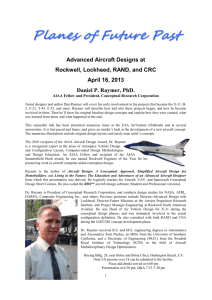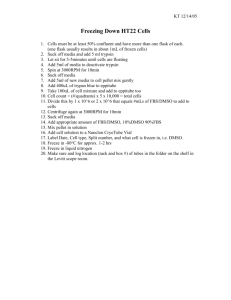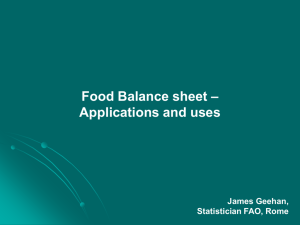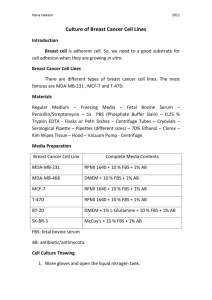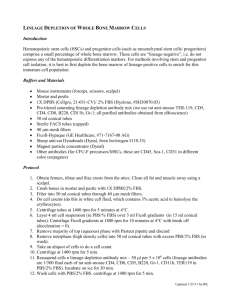A Genetic Algorithm Based Approach to Understanding Protein
advertisement
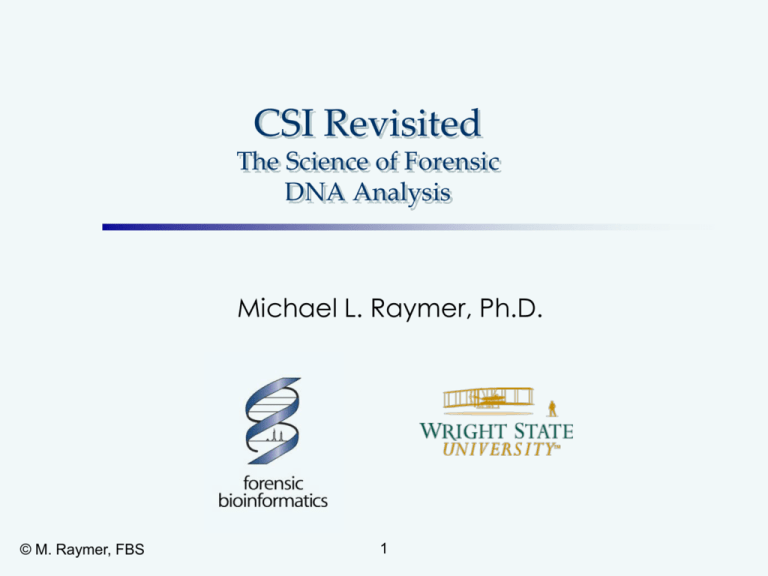
CSI Revisited The Science of Forensic DNA Analysis Michael L. Raymer, Ph.D. © M. Raymer, FBS 1 Growth in the importance of DNA Roughly 900,000 felony convictions per year in the U.S. DNA profiles are generated primarily for sexual offenses, murder, and assault • Often the key source of physical evidence The F.B.I. has established the CODIS database, with over 2 million DNA profiles • Allows “cold hit” searches for unresolved cases © M. Raymer, FBS 2 DNA evidence misconceptions Everyone’s DNA profile is unique DNA testing is always an objective and scientific process DNA testing is infallible DNA evidence is carefully evaluated by both the prosecution and the defense © M. Raymer, FBS We’ve got him cold. 3 Science and Art The science of DNA testing is sound but not all DNA testing is done scientifically © M. Raymer, FBS 4 Background: DNA DNA is found in each human cell Type of Sample Blood 1cm2 stain 1mm2 stain Semen postcoital vaginal swab Hair plucked shed Saliva Urine © M. Raymer, FBS Amount of DNA 30,000 ng/mL 200 ng 2 ng 250,000 ng/mL 0 – 3,000 ng 1 – 750 ng/hair 1 – 12 ng/hair 5,000 ng/mL 1 – 20 ng/mL 5 Background: DNA structure DNA is a polymer of nucleotides • Four building blocks: A, C, G, T © M. Raymer, FBS 6 Background: DNA information content Most DNA (as much as 90%) is noncoding, or “junk” DNA More than 99% of the DNA is identical between any two humans • Regions of difference: “polymorphic” Changes to DNA are random, and usually bad Non-coding DNA exhibits higher polymorphism © M. Raymer, FBS 7 STRs Short Tandem Repeat = STR Describes a type of DNA polymorphism in which: • a DNA sequence repeats • over and over again • and has a short (usually 4 base pair) repeat unit A length polymorphism – alleles differ in their length 3 repeats: AATG AATG AATG 4 repeats: AATG AATG AATG AATG 5 repeats: AATG AATG AATG AATG AATG 6 repeats: AATG AATG AATG AATG AATG AATG © M. Raymer, FBS 8 13 CODIS core STR loci TPOX D3S1358 D8S1179 D5S818 FGA CSF1PO TH01 VWA D7S820 AMEL D13S317 D16S539 © M. Raymer, FBS D18S51 9 D21S11 AMEL Short Tandem Repeats (STRs) AATG 7 repeats 8 repeats the repeat region is variable between samples while the flanking regions where PCR primers bind are constant Homozygote = both alleles are the same length Heterozygote = alleles differ and can be resolved from one another © M. Raymer, FBS 10 Extract and Purify DNA Add primers and other reagents © M. Raymer, FBS 11 PCR Amplification DNA regions flanked by primers are amplified Groups of amplified STR products are labeled with different colored dyes (blue, green, yellow) © M. Raymer, FBS 12 Profiler Plus: After Amplification © M. Raymer, FBS 13 The ABI 310 Genetic Analyzer: © M. Raymer, FBS 14 Capillary Electrophoresis Amplified STR DNA injected onto column Electric current applied DNA pulled towards the positive electrode DNA separated out by size: • Large STRs travel slower • Small STRs travel faster Detector Window Color of STR detected and recorded as it passes the detector © M. Raymer, FBS 15 ‘Nested’ STR alleles: Profiler Plus Small 16 17 D3S1358 Medium D8S1179 8 12 D5S818 © M. Raymer, FBS 21 BLUE 15,15 23 FGA vWA 28 16,16 Large 14 GREEN 29 19 D18S51 D21S11 YELLOW 11 13 10,10 D7S820 D13S317 16 Profiler Plus: Raw data © M. Raymer, FBS 17 • GENESCAN divides the raw data into a separate electropherogram for each color: •Blue •Green •Yellow •Red •The type of this sample is: –D3: 16, 17 •GENOTYPER identifies the –vWA: 15, 15 makes different loci and 21,23 the –FGA: allele calls –Amelogenin: X, Y –D8: 16, 16 –D21: 28, 29 –D18: 14, 19 RAW DATA D3 vWA Am D8 –D5: 8, 12 –D13: 11, 13 –D7: 10 10 © M. Raymer, FBS D5 FGA D21 D18 D13 D7 PROCESSED DATA 18 Reading an electropherogram BLUEFGA D3 vWA D8 D21 GREEN Amelogenin XX = female XY = male Amelogenin D5 D13 D7 YELLOW Peaks correspond to alleles © M. Raymer, FBS D18 RED 19 Statistical estimates: product rule 0.222 x 0.222 x 2 = 0.1 © M. Raymer, FBS 20 The product rule 1 in 10 x 1 in 111 x 1 in 20 = 0.1 1 in 22,200 1 in 100 x 1 in 14 x 1 in 81 1 in 113,400 1 in 116 x 1 in 17 x 1 in 16 1 in 31,552 1 in 79,531,528,960,000,000 © M. Raymer, FBS 121in 80 quadrillion Profiler Plus D3S1358 AMEL VWA D8S1179 D5S818 © M. Raymer, FBS FGA D21S11 D13S317 22 D18S51 D7S820 Cofiler D3S1358 AMEL D16S539 TH01 TPOX CSF1PO D7S820 © M. Raymer, FBS 23 Identifiler D8S1179 D7S820 CSF1PO D21S11 D3S1358 TH01 D13S317 D16S539 D2S1338 D19S433 VWA AMEL © M. Raymer, FBS TPOX D5S818 D18S51 FGA 24 Components of a DNA report The samples tested • Evidence samples (crime scene) • Reference samples (defendant, suspect) The lab doing the testing The test used: • Profiler Plus, Cofiler, Identifiler, mtDNA The analyst who did the testing Results and conclusions: • Table of alleles • Narrative conclusions © M. Raymer, FBS 25 Table of alleles Some labs include more information than others Usually includes information about mixed samples May also include: • Indication of low level results • Indication of results not reported • Relative amounts of different alleles (in mixed samples) No standard format © M. Raymer, FBS 26 Narrative conclusions Indicates which samples match Includes a statistical estimate Identifies samples as mixed May include an ‘identity statement’ i.e., samples are from the same source to a scientific degree of certainty (FBI) May allude to problems (e.g. interpretative ambiguity, contamination) © M. Raymer, FBS 27 Sources of ambiguity in STR interpretation Degradation Allelic dropout False peaks Mixtures Accounting for relatives Threshold issues -- marginal samples © M. Raymer, FBS 28 Degradation S M A L L L A R G E When biological samples are exposed to adverse environmental conditions, they can become degraded • Warm, moist, sunlight, time Degradation breaks the DNA at random Larger amplified regions are affected first Classic ‘ski-slope’ electropherogram Peaks on the right lower than peaks on the left © M. Raymer, FBS 29 Allelic Dropout Reference sample 1500 Evidence sample ? Peaks in evidence samples all very low Peaks in reference sample much higher At D13S817: 14 allele has dropped out -- or has it? Tend to see with ‘marginal samples’ © M. Raymer, FBS • Mostly below 150 rfu • All well above 800 rfu • Reference sample: 8, 14 • Evidence sample: 8, 8 30 150 False peaks & machine problems False peaks: • • • • Contamination Dye blob Electrical spikes Pull-up Machine problems: • Noise • Baseline instability • Injection failures © M. Raymer, FBS 31 Summary Sheet The * indicates that this peak may be involved in pullup… © M. Raymer, FBS 32 Analysis Report A locus by locus description of issues that may warrant further review by an expert, including: • Peak height imbalance • Presence of a mixture • Possible degradation • Possible pullup • Inconsistent results from multiple runs • Problems with control runs and reagent blanks © M. Raymer, FBS We reviewed the data using our standard screening procedure, which employs GeneScan v3.7.1 and GenoTyper v3.7 (the same software used by the forensic DNA testing laboratory) to examine the test results. Our analysis has identified the following issues that might be important to your interpretation of the DNA evidence in this case. All of these issues warrant further review by an expert. All of the statements listed below about the data in your case can be verified by any competent expert who has access to GeneScan and GenoTyper software and to the data you provided to us. GeneScan and GenoTyper are proprietary software programs licensed by Applied Biosystems International. The reference samples of the victim, "Jane Doe", and "Jane Doe-C", Jane Doe-C displays peak height imbalance at the locus CSF. The difference in the peak heights of the 13 and 11 alleles for the CSF locus (51 and 889, respectively) could be the result of a technical artifact (such as primer binding site mutations), or be evidence of more than one contributor to that sample. Jane Doe is consistent with its source being a mixture of two or more individuals. Two loci, D3 (Allele 14 - 1079 RFUs, Allele 15 - 926 RFUs, Allele 16*a - 102 RFUs) and D21 (Allele 27 806 RFUs, Allele 32.2 - 695 RFUs, Allele 34.2 - 56 RFUs) appear to have more than two alleles. The additional peaks in this reference sample were found to be below the threshold of 150 RFUs, indicating that they are possibly caused by stochastic effects. Some additional peaks may be due to an uncommon technical artifact known as +4 stutter. A mixture in a reference sample could indicate that contamination has occurred. 33 What can be done to make DNA testing more objective? • Distinguish between signal and noise Deducing the number of contributors to mixtures Accounting for relatives © M. Raymer, FBS 34 Where do peak height thresholds come from (originally)? • Applied Biosystems validation study of 1998 • Wallin et al., 1998, “TWGDAM validation of the AmpFISTR blue PCR Amplification kit for forensic casework analysis.” JFS 43:854-870. © M. Raymer, FBS 35 Where do peak height thresholds come from (originally)? © M. Raymer, FBS 36 Where do peak height thresholds come from? • “Conservative” thresholds established during validation studies • Eliminate noise (even at the cost of eliminating signal) • Can arbitrarily remove legitimate signal • Contributions to noise vary over time (e.g. polymer and capillary age/condition) Analytical chemists use LOD and LOQ © M. Raymer, FBS 37 Signal Measure Measured signal (In Volts/RFUS/etc) Saturation Quantification limit μb + 10σb μb + 3σb Detection limit Mean background Signal μb 0 © M. Raymer, FBS 38 Opportunities to measure baseline © M. Raymer, FBS 39 Control samples • Negative controls: 5,932 data collection points (DCPs) per run ( = 131 DCPs) • Reagent blanks: 5,946 DCPs per run ( = 87 DCPs) • Positive controls: 2,415 DCP per run ( = 198 DCPs) • DCP regions corresponding to size standards and 9947A peaks (plus and minus 55 DCPs to account for stutter in positive controls) were masked in all colors © M. Raymer, FBS 40 RFU levels at all non-masked data collection points 250 200 Count 150 100 50 0 1 2 3 4 5 6 7 8 9 10 11 12 13 14 15 16 17 18 19 20 21 22 23 24 25 26 RFU © M. Raymer, FBS 41 27 28 29 30 Variation in baseline noise levels Positive Control Maximum Average Minimum Negative Control Maximum Average Minimum Reagent Blank Maximum Average Minimum All three controls averaged Maximum Average Minimum b b b + 3b b + 10b 6.7 5.0 3.7 6.9 3.7 2.4 27.4 16.1 10.9 75.7 42.0 27.7 b b b + 3b b + 10b 13.4 5.4 4.0 13.2 3.9 2.6 53.0 17.1 11.8 145.4 44.4 30.0 b b b + 3b b + 10b 6.5 5.3 4.0 11.0 4.0 2.6 39.5 17.3 11.8 116.5 45.3 30.0 b b b + 3b b + 10b 7.1 5.2 3.9 7.3 3.9 2.5 29.0 16.9 11.4 80.1 44.2 28.9 Average (b) and standard deviation (b) values with corresponding LODs and LOQs from positive, negative and reagent blank controls in 50 different runs. BatchExtract: ftp://ftp.ncbi.nlm.nih.gov/pub/forensics/ © M. Raymer, FBS 42 Lines in the sand: a 2-person mix? Two reference samples in a 1:10 ratio (male:female). Three different thresholds are shown: 150 RFU (red); LOQ at 77 RFU (blue); and LOD at 29 RFU (green). © M. Raymer, FBS 43 Familial searching Database search yields a close but imperfect DNA match Can suggest a relative is the true perpetrator Great Britain performs them routinely Reluctance to perform them in US since 1992 NRC report Current CODIS software cannot perform effective searches Three approaches to familial searches Search for rare alleles (inefficient) Count matching alleles (arbitrary) Likelihood ratios with kinship analyses Pair-wise similarity distributions 20% 18% Percent of total (%) 16% 14% 12% Randomized Individuals 10% Simulated Cousins Simulated Siblings 8% 6% 4% 2% 0% 2 4 6 8 10 12 14 16 18 Number of pairwise shared alleles 20 22 24 Is the true DNA match a relative or a random individual? Given a closely matching profile, who is more likely to match, a relative or a randomly chosen, unrelated individual? Use a likelihood P Eratio | relative LR P( E | random) Is the true DNA match a relative or a random individual? What is the likelihood that a relative of a single initial suspect would match the evidence sample perfectly? What is the likelihood that a single randomly chosen, unrelated individual would match the evidence sample perfectly? PE | relative LR P( E | random) Probabilities of siblings matching at 0, 1 or 2 alleles Pa Pb HF , if 4 Pb Pa Pb HF P( E | sib ) , if 4 1 Pa Pb Pa Pb HF , if 4 shared 0 shared 1 shared 2 HF = 1 for homozygous loci and 2 for heterozygous loci; Pa is the frequency of the allele shared by the evidence sample and the individual in a database. Probabilities of parent/child matching at 0, 1 or 2 alleles 0, if Pb P( E | parent / child ) , if 2 Pa Pb , if 2 shared 0 shared 1 shared 2 HF = 1 for homozygous loci and 2 for heterozygous loci; Pa is the frequency of the allele shared by the evidence sample and the individual in a database. Other familial relationships Cousins: 6 Pa Pb HF , if 8 P 6 P P HF a b P( E | cousins ) b , if 8 Pa Pb 6 Pa Pb HF , if 8 2 P P HF Grandparent-grandchild; , 4 P 2 P P HF P ( E | GG / AUNN / HS ) , aunt/uncle-nephew-neice;half4 P P 2 P P HF , sibings: 4 a b a b a b b a HF = 1 for homozygous loci and 2 for heterozygous loci; Pa is the frequency of the allele shared by the evidence sample and the individual in a database. b shared 0 shared 1 shared 2 if shared 0 if shared 1 if shared 2 Familial search experiment Randomly pick related pair or unrelated pair from a synthetic database Choose one profile to be evidence and one profile to be initial suspect Test hypothesis: • H0: A relative is the source of the evidence • HA: An unrelated person is the source of the evidence Paoletti, D., Doom, T., Raymer, M. and Krane, D. 2006. Assessing the implications for close relatives in the event of similar but non-matching DNA profiles. Jurimetrics, 46:161-175. Hypothesis testing: LR threshold of 1 with prior odds of 1 True state Decision Evidence from unrelated individual Evidence from sibling Evidence from Unrelated individual Evidence from sibling ~ 98% [Correct decision] ~4% [Type II error; false negative] ~ 2% [Type I error; false positive] ~ 96% [Correct decision] Two types of errors False positives (Type I): an initial suspect’s family is investigated even though an unrelated individual is the actual source of the evidence sample. False negatives (Type II): an initial suspect’s family is not be investigated even though a relative really is the source of the evidence sample. A wide net (low LR threshold) catches more criminals but comes at the cost of more fruitless investigations. Type I and II errors with prior odds of 1 70% 60% 50% 40% Sibling false positive Sibling false negative 30% 20% 10% 0% 0.0001 0.001 0.01 0.1 1 10 100 1000 10000 Is the true DNA match a relative or a random individual? What is the likelihood that a close relative of a single initial suspect would match the evidence sample perfectly? What is the likelihood that a single randomly chosen, unrelated individual would match the evidence sample perfectly? PE | relative LR P(E | random) Is the true DNA match a relative or a random individual? What is the likelihood that the source of the evidence sample was a relative of an initial suspect? PE | sib Psib Psib | E PE | sib Psib PE | random Prandom Prior odds: s Psib popsize popsize s Prandom popsize Is the true DNA match a relative or a random individual? This more difficult question is ultimately governed by two considerations: • What is the size of the alternative suspect pool? • What is an acceptable rate of false positives? PE | sib LR P( E | random) Pair-wise similarity distributions 20% 18% Percent of total (%) 16% 14% 12% Randomized Individuals 10% Simulated Cousins Simulated Siblings 8% 6% 4% 2% 0% 2 4 6 8 10 12 14 16 18 Number of pairwise shared alleles 20 22 24 How well does an LR approach perform relative to alternatives? Low-stringency CODIS search identifies all 10,000 parent-child pairs (but only 1,183 sibling pairs and less than 3% of all other relationships and a high false positive rate) Moderate and high-stringency CODIS searches failed to identify any pairs for any relationship An allele count-threshold (set at 20 out of 30 alleles) identifies 4,233 siblings and 1,882 parent-child pairs (but fewer than 70 of any other relationship and with no false positives) How well does an LR approach perform relative to alternatives? LR set at 1 identifies > 99% of both sibling and parent-child pairs (with false positive rates of 0.01% and 0.1%, respectively) LR set at 10,000 identifies 64% of siblings and 56% of parent-child pairs (with no false positives) Use of non-cognate allele frequencies results in an increase in false positives and a decrease in true positives (that are largely offset by either a ceiling or consensus approach) Introduction to Mixtures Mixtures can exhibit up to two peaks per contributor at any given locus Mixtures can exhibit as few as 1 peak at any given locus (regardless of the number of contributors) © M. Raymer, FBS 62 Introduction to Mixtures Determining if two genotypes could be contributors is relatively easy Possible contributors to a mixture: D3 locus genotype Individual #1: 15, 18 Individual #2: 14, 18 Mixture: 14, 15, 18 But beware – the opposite is not true © M. Raymer, FBS 63 Introduction to Mixtures Determining what genotypes created the mixture is non-trivial D3 locus genotype 14, 15, 18 Mixture: © M. Raymer, FBS Option #1 Individual A: 15, 18 Individual B: 14, 18 Option #3 Individual #D: Individual #E: 14, 15 18, 18 Option #2 Individual B: 14, 18 Individual C: 15, 15 Option #4 Individual #A: Individual #F: 15, 18 14, 14 64 Introduction to Mixtures Even determining the number of contributors is non-trivial D3 locus genotype 14, 15, 18 Mixture: Another Option Individual C: Individual D: Individual E: 15, 15 14, 15 18, 18 There is no “hard” mathematical upper bound to the number of contributors possible © M. Raymer, FBS 65 Introduction to Mixtures Usually the victim’s genotype is known, but this does not always make the defendant’s genotype clear D3 locus genotype 14, 15, 18 14, 15 Mixture: Victim: Possible genotypes for a single perpetrator: Individual C: 14, 18 Individual D: 15, 18 Individual E: 18, 18 Individual F: © M. Raymer, FBS 66 14, 14 ? Introduction to Mixtures The large number of potential genotypes consistent with the mixture allows for a VERY wide net to be cast • This greatly increases the likelihood of accusing an innocent suspect, particularly in database trawls • This is generally not reflected in the statistics reported by the DNA testing laboratory • Case History: Sutton © M. Raymer, FBS 67 Making sense of mixtures There are two major open research areas: • Determining the most likely number of contributors • Determining the genotypes of each contributor Factors that can aid in deconvolution • Mixture ratios • Peak height additivity Factors that can greatly complicate deconvolution results • Allowing alleles to be discarded as artifacts (“analyst’s discretion”) © M. Raymer, FBS 68 Mixture ratios Different individuals may contribute different “amounts” of DNA to the mixture. This difference should be reflected (relatively uniformly) throughout the entire sample. © M. Raymer, FBS 69 Peak height additivity Assume one individual contributes an amount of DNA that measured at n RFUs Assume a second individual contributes an amount of DNA that measures at m RFUs In a two person mixture, any allele which they share should measure at roughly n + m RFUs © M. Raymer, FBS 70 Evidence of additivity 8000 7000 Larger peak (in RFUs) 6000 5000 4000 3000 2000 1000 0 0 1000 2000 3000 4000 5000 6000 7000 8000 Smaller peak (in RFUs) Relationship between the smaller and larger peaks in heterozygous loci of reference samples. © M. Raymer, FBS 71 Making sense of mixtures There are two major research areas: • Determining the most likely number of contributors • Determining the genotypes of each contributor How can we determine the mostly likely number of contributors? • We (Paoletti et al.) create mixtures from an existing database in order to determine how often the actual number of contributors differs from the perceived number of contributors. • The Minnesota BCA database uses twelve (12) loci © M. Raymer, FBS 72 Minnesota BCA database BCA ID# D3S1358 vWA FGA THO1 TPOX CSF1PO D5S818 D13S317 D7S820 D8S1179 D21S11 PB0005 PH0070 PH0138 Mixture1 17,18 15,17 17,17 15,17,18 16,16 16,17 14,16 14,16,17 21,24 21,25 24,25 21,24,25 6,8 7,7 7,8 6,7,8 10,11 10,11 11,11 10,11 11,12 11,12 10,11 10,11,12 12,14 11,12 11,11 11,12,14 11,12 11,12 10,10 10,11,12 8,10 8,10 10,11 8,10,11 13,14 13,14 14,14 13,14 29,29.2 29.2,30 29,30 29,29.2 PB0155 PH0014 PN0166 Mixture2 16,17 17,17 15,16 15,16,17 16,16 17,18 17,17 16,17,18 24,24 19,22 19,22 19,22,24 8,9.3 6,9.3 9.3,9.3 6,8,9.3 10,11 11,12 11,11 10,11,12 11,12 12,12 12,13 11,12,13 11,13 11,11 11,11 11,13 12,12 9,9 12,13 9,12,13 10,11 11,11 9,10 9,10,11 12,15 13,15 12,12 12,13,15 29,29 28,29 30,30 28,29,3 PB0022 PB0078 PH0146 Mixture3 15,16 15,17 17,17 15,16,17 15,16 15,15 16,16 15,16 22,23 23,24 24,24 22,23,24 7,7 7,8 8,9.3 7,8,9.3 9,11 10,10 9,11 9,10,11 11,12 11,12 10,12 10,11,12 11,12 11,12 12,12 11,12 14,14 13,13 8,8 8,13,14 11,12 10,10 10,12 10,11,12 14,15 13,13 13,14 13,14,15 32.2,35 28,28 28,32.2 28,32.2 PB0024 PB0067 PB0111 Mixture4 17,18 17,18 15,18 15,17,18 16,18 16,19 16,16 16,18,19 22,24 22,24 23,24 22,23,24 7,8 7,8 8,9.3 7,8,9.3 6,9 11,11 6,9 6,9,11 10,11 10,10 10,11 10,11 11,11 12,13 11,12 11,12,13 9,12 11,12 11,12 9,11,12 8,10 8,8 10,12 8,10,12 15,15 12, 13 12,15 12,13,15 29,29 29,30 30,31 29,30,3 PB0024 PB0075 PC0090 Mixture5 17,18 16,18 16,17 16,17,18 16,18 16,16 14,18 14,16,18 22,24 22,24 22,25 22,24,25 7,8 9.3,9.3 7,8 7,8,9.3 6,9 8,8 8,8 6,8,9 10,11 7,10 10,11 7,10,11 11,11 8,11 12,12 8,11,12 9,12 11,11 11,11 9,11,12 8,10 8,8 8,12 8,10,12 15,15 14,14 12,15 12,14,15 29,29 29,32.2 29,30 29,30,3 PB0030 PH0055 PN0108 Mixture6 14,16 16,16 15,16 14,15,16 15,15 16,18 18,18 15,16,18 22,22 24,24 22,23 22,23,24 7,7 7,9 9.3,9.3 7,9,9.3 8,9 8,11 11,11 8,9,11 11,11 11,12 11,11 11,12 11,13 11,12 11,11 11,12,13 12,13 12,14 12,14 12,13,14 10,11 8,11 8,8 8,10,11 14,16 13,14 14,16 13,14,16 28,29 28,29 29,30 28,29,3 © M. Raymer, FBS 73 All 3-way MN BCA mixtures • There are 45,139,896 possible different 3-person mixtures of the 648 individuals in the MN BCA database Maximum # of alleles observed 2 # of occurrences 0 As Percent 0.00% 3 310 0.00% 4 2,498,139 5.53% 5 29,938,777 66.32% 6 12,702,670 28.14% 6% of three contributors mixtures “look like” two contributors © M. Raymer, FBS 74 All 3-way MN BCA mixtures • What if “analyst’s discretion” is invoked exactly once (at the “worst” locus) Maximum # of alleles observed 1, 2 # of occurrences As Percent 0 0.00% 0 0.00% 3 310 0.00% 8,151 0.02% 4 2,498,139 5.53% 11,526,219 25.53% 5 29,938,777 66.32% 32,078,976 71.01% 6 12,702,670 28.14% 1,526,550 3.38% 26% of three contributors mixtures “look like” two contributors © M. Raymer, FBS 75 All 4-way MN BCA mixtures Maximum # of alleles observed 1, 2, 3 # of occurrences As Percent 0 0.00% 6 0.00% 4 42,923 0.07% 731,947 1.25% 5 9,365,770 15.03% 30,471,965 52.18% 6 34,067,153 58.32% 25,872,024 44.29% 7 13,719,403 23.49% 1,328,883 2.28% 8 1,214,261 2.08% 4,695 0.01% 73% of four contributors mixtures “look like” three contributors © M. Raymer, FBS 76 All 4-way MN BCA mixtures Maximum # of alleles observed 1, 2, 3 # of occurrences As Percent 0 0.00% 6 0.00% 4 42,923 0.07% 731,947 1.25% 5 9,365,770 15.03% 30,471,965 52.18% 6 34,067,153 58.32% 25,872,024 44.29% 7 13,719,403 23.49% 1,328,883 2.28% 8 1,214,261 2.08% 4,695 0.01% 96% of four contributors mixtures “look like” three contributors when one locus can be dropped from consideration © M. Raymer, FBS 77 Removing possible relationships vWA Individual Original Redistributed 1 18,19 15,18 2 18,18 18,18 . . . . . . . . . 648 14,15 14,19 Redistribute alleles at each locus randomly New database of “synthetic” unrelated individuals with the same allele frequencies © M. Raymer, FBS 78 3-way mixtures with all 12 loci Maximum # of alleles observed in a 3-person mixture # of occurrences Maximum # of alleles observed in a 3person mixture Percent of mixtures # of occurrences Percent of mixtures 2 0 0.00% 2 0.0 0.00% 3 310 0.00% 3 139.4 0.00% 4 2,498,139 5.53% 4 2,233,740.8 4.95% 5 29,938,777 66.32% 5 29,829,482.0 66.08% 6 12,702,670 28.14% 6 13,076,533.8 28.97% © M. Raymer, FBS MN BCA Original Data 79 Synethtic “Unrelated” Data How many loci until 4-way mixture doesn’t look like a 3-way mixture? 4-Way Mixtures, CAU MN Data, Average 80% % Misclassified 70% 60% 50% 40% 30% 20% 10% 0% 12 24 36 48 60 72 84 96 108 120 132 144 Loci Redistribute alleles across all individuals (by locus) and add to database © M. Raymer, FBS 80 What if contributors are related? Clearly, determining the number of contributors to a DNA mixture is difficult when the contributors are unrelated How much harder does it become when they are related? © M. Raymer, FBS 81 Virtual families P F1 F2 G1 G2 P1 G3 G4 G5 P2 P3 C1 G6 P4 C2 Parents randomly chosen from unrelated (randomized) database Random mating Creates databases of grandparents, parents, and grandchildren © M. Raymer, FBS 82 Distributions of shared alleles 20% 18% 16% Percent of Total 14% 12% Unrelated 10% Cousins Siblings 8% 6% 4% 2% 0% 1 2 3 4 5 6 7 8 9 10 11 12 13 14 15 16 17 18 19 20 21 22 23 24 Num ber of Shared Alleles © M. Raymer, FBS 83 Likelihoods of shared alleles 100% 90% 80% Likelihood 70% 60% Unrelated 50% Cousins 40% Siblings 30% 20% 10% 0% 1 2 3 4 5 6 7 8 9 10 11 12 13 14 15 16 17 18 19 20 21 22 23 24 Number of Shared Alleles © M. Raymer, FBS 84 Analysis of Allele Sharing Clearly, it is difficult to definitively assign the number of contributors to a mixture This difficulty must be fairly reported in random probability match statistics in order for such statistics to remain objective Analyst discretion should be invoked cautiously, and always carefully doublechecked for error Likelihoods allow a analysts to infer the possible relationship between two individuals © M. Raymer, FBS 85 Mixture Deconvolution Even when the number of contributors is known (or assumed), separating mixtures into their components can be difficult Contrib 1 16,16 16,17 16,16 17,17 © M. Raymer, FBS 86 Contrib 2 17,17 16,17 16,17 16,17 Current Methods Most methods start by inferring the mixture ratio: High peak avg. Low peak avg. Simple example: All loci heterozygous, two contributors © M. Raymer, FBS 87 Minimal Basic Assumptions A primary assumption of all methods is peak additivity Most labs assume peaks from the same source will vary by 30% © M. Raymer, FBS 88 Objectives Start with simple assumptions: • Additivity with constant variance: c • Peaks below a minimum threshold (often 50 or 150 RFU) are not observable • Peaks above the saturation threshold (often 4000 RFU) are not measurable Obtain provably correct deconvolution where possible Identify when this is not possible © M. Raymer, FBS 89 Method Assume the number of contributors Enumerate all possible mixture contributor combinations Determine which pairs of profiles contain peaks in balance © M. Raymer, FBS 90 Peak Balance Example: assume two contributors, four peaks: • For this locus, and c = 1.3, the combination (P1,P3) is out of balance because: 2080 RFU 2030 RFU 210 RFU 180 RFU P3 P4 P1 P2 180 c 2030 © M. Raymer, FBS Peaks are numbered by height 91 Example: Mixture of four peaks Contributor 1 Contributor 2 Mixture Condition 1 Mixture Condition 2 P4 P3 P2 P1 P4 cP3 P2 cP1 P4 P2 P3 P1 P4 cP2 P3 cP1 P4 P1 P3 P2 P4 cP1 P3 cP2 P4 >= P3 >= P2 >= P1 >= Min. Threshold © M. Raymer, FBS 92 Sweet Spot Contributor 1 Contributor 2 Mixture Condition 1 Mixture Condition 2 P4 P3 P2 P1 P4 cP3 P2 cP1 P4 P2 P3 P1 P4 cP2 P3 cP1 P4 P1 P3 P2 P4 cP1 P3 cP2 If only one row is satisfied, then the genotypes can be unambiguously and provably determined © M. Raymer, FBS 93 Example: In the sweet spot Contributor 1 Contributor 2 Mixture Condition 1 Mixture Condition 2 P4 P3 P2 P1 P4 cP3 P2 cP1 P4 P2 P3 P1 P4 cP2 P3 cP1 P4 P1 P3 P2 P4 cP1 P3 cP2 P4 > cP2 so we can’t have (P4,P2) P4 > cP1 so we can’t have (P4, P1) 2080 RFU 2030 RFU 210 RFU 180 RFU P3 P4 P1 P2 © M. Raymer, FBS 94 Example: Ambiguous Locus Contributor 1 Contributor 2 Mixture Condition 1 Mixture Condition 2 P4 P3 P2 P1 P4 cP3 P2 cP1 P4 P2 P3 P1 P4 cP2 P3 cP1 P4 P1 P3 P2 P4 cP1 P3 cP2 P2 is within c of both P1 and P4, so we can have • (P1,P3) (P2,P4), or • (P1,P2) (P3,P4) P4 cannot pair with P1 © M. Raymer, FBS 245 RFU 230 RFU 190 RFU 180 RFU P3 P4 P1 P2 95 Example: No row satisfied Contributor 1 Contributor 2 Mixture Condition 1 Mixture Condition 2 P4 P3 P2 P1 P4 cP3 P2 cP1 P4 P2 P3 P1 P4 cP2 P3 cP1 P4 P1 P3 P2 P4 cP1 P3 cP2 P4 (for example) cannot pair with any other peak One of our assumptions (c or the number of contributors) is incorrect © M. Raymer, FBS 700 RFU 500 RFU 300 RFU 200 RFU P3 P4 P1 P2 96 Three Peaks Contributor 1 Contributor 2 Mixture Condition 1 Mixture Condition 2 P3 P3 P2 P1 None (homozygote) P2 c P1 P3 P2 P3 P1 P3 c (P2+P1) P3 (1/c) (P2+P1) P3 P2 P2 P1 P2 c (P3+P1) P2 (1/c) (P3+P1) P3 P2 P1 Pmpht P3 c P2 P1 c Pmpht P3 P2 P1 P1 P3 c P2 None P3 P1 P2 Pmpht P3 c P1 P2 c Pmpht P3 P1 P2 P2 P3 c P1 None P3 P1 P2 P1 P1 c (P3+P2) P1 (1/c) (P3+P2) P3 Pmpht P2 P1 P3 c Pmpht P2 c P1 © M. Raymer, FBS 97 Advantages of the method If you accept the simple assumptions, the resulting mixture interpretations directly follow Interprets mixtures on a locus by locus basis Does not interpret ambiguous loci © M. Raymer, FBS 98 Future work Mixture ratio can be inferred only from unambiguous loci, and then applied to perform an more aggressive interpretation of the ambiguous loci when desired Confidence values can be applied to the more aggressively interpreted possitions © M. Raymer, FBS 99 Acknowledgements Research Students • David Paoletti (analysis of allele sharing) • Jason Gilder (data collection, additivity study, mixture deconvolution) Faculty • Travis Doom • Dan Krane • Michael Raymer © M. Raymer, FBS 100

